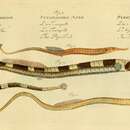Diagnostic Description
provided by Fishbase
Light greenish to dark brown in color with variable markings (Ref. 4281). Snout cylindrical, equal to or less than eye diameter. With 18 - 19 body rings between head and dorsal fin (Ref. 35388). The snake pipefish (Entelurus aequoreus) is distinguished by the lack of pectoral and anal fins (Ref. 88171). An elongated bump on top of head behind eye (Ref. 59043).
- Recorder
- Cristina V. Garilao
Life Cycle
provided by Fishbase
Ovoviviparous; reproducing on average 3 times each year (Ref. 89328). Several females depositing partial clutches to a maleâs brood pouch under the tail (Refs. 205, 31201). Up to 400 eggs may be found in a single pouch (Ref. 89329). Brooding males occur mainly between May and July (Refs. 31201, 58137). During the breeding season, both males and females were observed to remain low amongst the seagrass in one meadow (Ref. 31201). Gestation period lasts about 5 weeks and size at birth is 1.7- 3.5 cm (Refs. 58137, 88187, 89330). Aquarium experiments have shown that new born young are benthic, remaining close to the bottom Ref. 89330).
Morphology
provided by Fishbase
Dorsal spines (total): 0; Dorsal soft rays (total): 33 - 42; Analspines: 0; Analsoft rays: 3
- Recorder
- Cristina V. Garilao
Trophic Strategy
provided by Fishbase
Visual, low-level predator. Feeds primarily during the day (Ref. 58137), preying mainly on small crustaceans (Ref. 89327).
Biology
provided by Fishbase
Found in coastal and estuarine waters to depths of at least 110 m (Ref. 4281); on sand, mud and rough bottoms. Common amongst algae and eel-grass (Zostera) (Refs. 4146, 6733, 88187). Feeds mainly on small crustaceans (Ref. 85544). It is parasitised by the monogenean Gyrodactylus eyipayipi on the body surface, inside the flute and male brood pouch (Ref. 124059).
- Recorder
- Christine Papasissi
Importance
provided by Fishbase
fisheries: of no interest; aquarium: commercial
- Recorder
- Christine Papasissi

